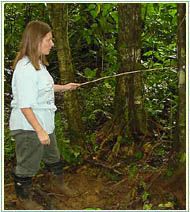Nectaries
Another job we have is helping the scientists, Lee and Grant, run the nectary tests. The purpose of the tests is to find out if certain caterpillars or the plants they eat contain chemical compounds that repel the caterpillars' enemies, or the reverse and maybe attract them.
The scientists are using "Bala" ants as "test" predators. "Bala" is the Spanish word for bullet and should give you some idea about how painful its sting can be! They are the largest and most primitive ants in Costa Rica and their soldiers can be up to 1 inch in length!
To set up the tests we prepare little plastic vials, or "nectaries," with sugar water to attract the bala ants. Half of the vials we fill with solutions of plain sugar water; the other half with sugar water plus plant chemicals prepared from Piper plants or ground-up caterpillar guts. Each vial is weighed before we take it into the field.
In the field one vial of the plain sugar water and one vial of the sugar water mixed with plant chemicals are carefully hung on a tree where there is an active "bala" ant colony below. Usually you can see a few ants busily going up and down the trunk of the tree and climbing on the leaves. We leave the vials for one hour.
 |
 |
 |

Brushing off the bullet ants with a long stick.
|
 |
 |
 |
By the time we return, bala ants are swarming around the vials and we have to use sticks to knock them off before reaching for the vial. We use light colored sticks to make it easier to notice the ants if they try to climb up the stick towards us. Another person watches our feet so that the ants won't climb up our boots and sting us. In spite of all these precautions, two people did get stung on the second day — one for the second time!
Back in the lab, the vials are weighed again. After many, many trials, Lee and Grant compare the amounts of plain sugar water left in the vials with the amounts of the sugar water plus plant chemicals. They are finding that the ants are eating less of the sugar water with the plant chemicals.
This may mean that chemicals in the Piper plant, are, in fact, keeping the Bala ants away, and that the caterpillar that eats the Piper plant, and stores these poisons in its body uses the same chemicals to defend itself against the ants.
From other studies, the scientists are finding that the chemical defenses are not very effective against the parasitoid enemies - the parasitic wasps and flies that lay their eggs on or inside the caterpillar's body. These enemies may actually prefer the "chemically defended" caterpillars.

